
Yosemite Valley looks great from the bottom up, the top down, and even the middle out. For this neither-up-nor-down view over Yosemite Valley, visit Columbia Rock, a viewpoint on Yosemite Falls Trail perched about thousand feet up the north wall of Yosemite Valley. The hike from Camp 4 up to Columbia Rock is 2.2 miles round trip with 985 feet of elevation change. Of course, continuing up Yosemite Falls Trail leads to incredible views of Upper Yosemite Falls, so turning around a Columbia Rock is definitely optional.
Find Yosemite Falls Trail starting from Camp 4, a walk-in campground near Yosemite Valley Lodge. Those not staying at the campground can reach the trailhead by taking the Yosemite Valley Shuttle to the stop for Camp 4. Walk to the trailhead at the north end of the campground parking area.
Yosemite Falls Trail enters the woods and comes to an intersection with Valley Loop Trail, which meanders around the edges of Yosemite Valley. Lower Yosemite Fall Trail is to the right. Make a left and an immediate right to proceed up Yosemite Falls Trail. Past the junction, the trail curves past a trail mileage sign. While it doesn’t list Columbia Rock, rest assured that you are on the right track.
Ease around a large boulder (one of many that fell from the steep wall above) and pass a sign for the Yosemite Wilderness boundary. Yosemite Falls Trail launches up the side of Yosemite Valley, attacking a dense string of switchbacks that lead to Columbia Rock.
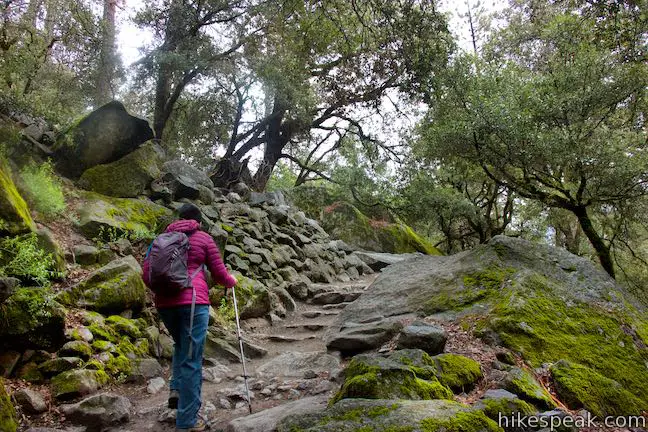
Ascend a talus slope shaded by a forest of live oaks that grow among the boulders. Admire the craftsmanship of the stone steps as you twist and turn up five dozen switchbacks. A sign at the bottom of the trail explains that John Conway laid out this route in the 1870s. John Muir called John Conway the master trail-builder of Yosemite Valley in his book, The Yosemite. Although the trail has certainly been improved in the last 150 years, the number of switchbacks may not have changed.
March up the steep steps, rising even higher up the side of the valley. Ponderosa pines, incense cedars, and bays laurels add variety to the oak-dominated forest.
As the train gains in altitude, it finally reaches some broader views. Cross a rocky area, 0.6 miles from Camp 4 where a seasonal stream flows over the trail during the spring snowmelt. Looking up, you may see an ephemeral waterfall sliding down the cliffs above, draining a small basin on the east side of Eagle Peak. This fleeting waterfall does not seem to have an official name (Conway Falls or Columbia Falls could be appropriate titles if none exists). The creek crossing the trail creates a gap in the forest, allowing you to look out across Yosemite Valley toward the rugged granite on the south wall. During spring months when the snow is melting along Glacier Point Road, you can watch Sentinel Falls drop like a white staircase on the opposite side of the valley, sliding 2,000 feet from the rim to the valley floor.
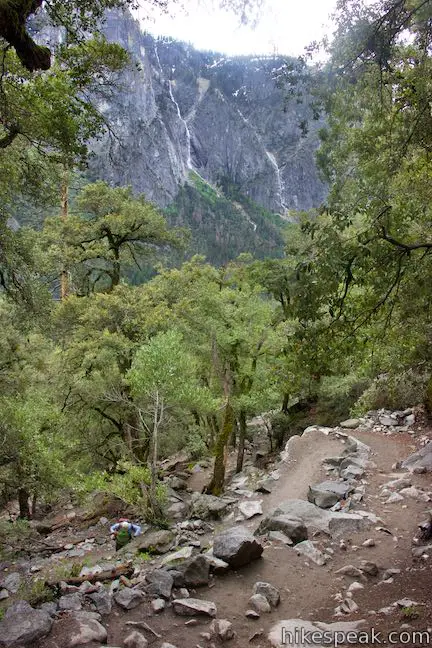
As a break from the dizzying switchbacks, the trail gets straighter for a stretch. After another tenth of a mile, an even bigger window opens through the trees looking out over Yosemite Valley.
Columbia Rock offers the best perspective yet, so proceed up another cluster of switchbacks. After a mile of hiking, you may spot some people on a rocky bench below the trail. This is not Columbia Rock, but seems to serve as an alternative – by choice or confusion. Just continue up the trail through a few more twists and turns to find an obvious spur on the right to Columbia Rock.
Columbia Rock Viewpoint
Step up to the metal railing at Columbia Rock and have a look out over a full sweep of Yosemite Valley. Initially, your eyes will be drawn east toward mighty Half Dome. The sheer face is dramatically exposed from this perspective. To the south of Half Dome, Mount Clark rises to a point among the more distant mountains.
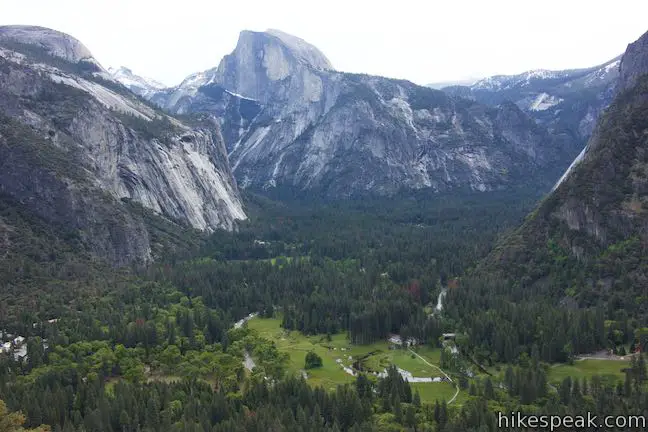

Across the valley to the south, the towering south wall rises to Sentinel Dome near Glacier Point. Sentinel Falls tumbles down one of the creases in the wall to the southwest. Farther to the west, the south wall gets more jagged at the Cathedral Rocks. To your right, the El Capitan-like face of Eagle Peak rises from the north side of the valley, blocking views of the real El Capitan.
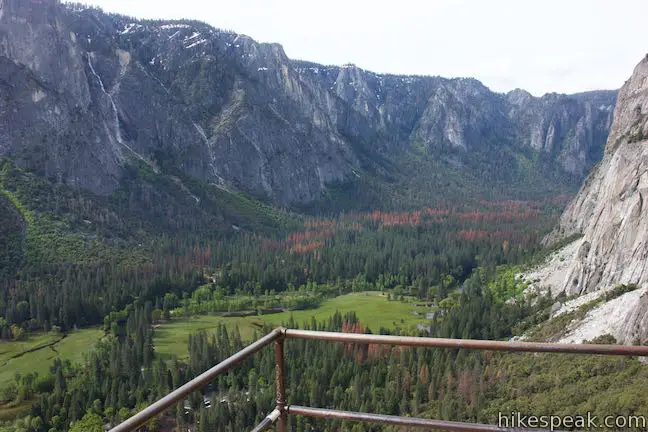
Yosemite Village is spread out below Columbia Rock, and a green forest-wrapped meadow stretches to the west end of Yosemite Valley. The Merced River snakes through it all. Things sure look small down there, which make sense since you climbed nearly a thousand feet to get to Columbia Rock. You are standing at around 4,975 feet of elevation and Yosemite Valley is at 4,000 feet.
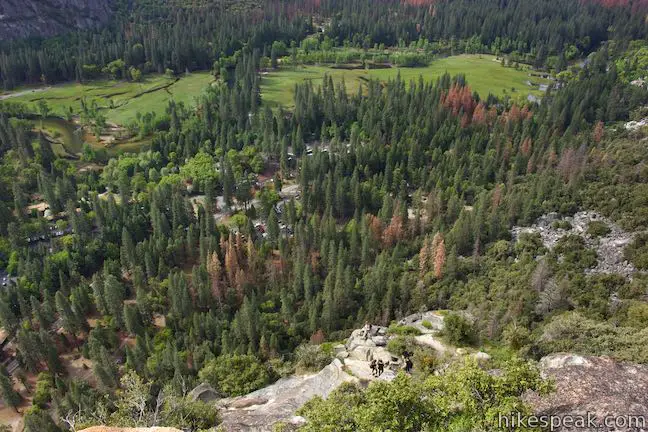
Yosemite Falls isn’t visible from Columbia Rock, but the 180-degree view from the side of Yosemite Valley makes this perch a definite highlight along Yosemite Falls Trail. The Columbia Rock perspective of Half Dome towering over Yosemite Valley is so fulfilling that many visitors turn around at Columbia Rock. The hike to Columbia Rock is 2.2-mile round trip hikes with 985 feet of elevation change. Yosemite Falls Trail continues for 2.4 miles from Columbia Rock to the top of Upper Yosemite Falls. The full trail has 2,715 feet of elevation change, so a major climb remains to reach the top. If you appreciate waterfalls, consider continuing at least another 2/3 of a mile up the tapering trail to the foot of Upper Yosemite Fall (you’ve already completed most of that climb).
Dogs and bikes are not allowed on Yosemite Falls Trail (also known as Upper Yosemite Fall Trail). This hike goes through Yosemite Wilderness, so a wilderness permits would be required if you hiked farther and stayed overnight. Day hikers do not need to acquire or carry permits. Yosemite National Park has an entrance fee.
Directions to the Trailhead
- Make your way into Yosemite Valley, parking where available near Yosemite Village or Curry Village.
- Take the free park shuttle to Stop 7 for Camp 4.
Trailhead Location
Trailhead address: Camp 4 Campground, Northside Drive, Yosemite Valley, CA 95389
Trailhead coordinates: 37.7423, -119.6021 (37° 44′ 32.3″N 119° 36′ 07.6″W)
View Yosemite National Park in a larger map
Or view a regional map of surrounding Sierra Nevada trails and campgrounds.
 | Yosemite Falls Trail This 3.5 to 7.1-mile hike rises from Yosemite Valley past Columbia Rock to unforgettable views of Upper Yosemite Fall. |
 | Lower Yosemite Fall Trail This 1.2-mile hike delivers visitors to the base of the tallest waterfall in North America. The experience is not to be missed. |
 | Bridalveil Fall Trail This easy paved half-mile trail visits the base of a 620-foot single-drop waterfall on the south side of Yosemite Valley. |
 | Mirror Lake This 2 to 2.8-mile hike visits a reflective pool on the east end of Yosemite Valley. |
 | Happy Isles This easy 0.75-mile hike explores a pair of islands in the Merced River at the east end of Yosemite Valley. |
 | Mist Trail This 1.8 to 6.1-mile hike takes an exciting course past Vernal Fall and Nevada Fall, two of Yosemite's prize waterfalls. |
 | Half Dome This epic 16-mile hike climbs 4,800 feet on one of Yosemite's most popular and most challenging trails. |
 | Panorama Trail This nearly 10-mile long one-way hike travels from Glacier Point down to Yosemite Valley in the most scenic way possible, ending with the Mist Trail. |
 | More trails in the Sierra Nevada Mountains Explore other destinations in Yosemite National Park and the rest of the range. |
 | Yosemite National Park Campgrounds Thirteen campgrounds with over 1,600 total sites are spread throughout the park to facilitate your visit, including Camp 4. |
 | Housekeeping Camp What's not a hotel and not a campground? Housekeeping Camp offers a different type of lodging in the middle of Yosemite Valley. |
Common Questions about Columbia Rock in Yosemite National Park
- Is the trail open?
- Yes. You should expect to find that Yosemite Falls Trail to Columbia Rock is open. There are no recent reports of trail closures. If you discover that the trail is closed, please help your fellow hikers by reporting a closure.
- Do I need a permit for this hike?
- Yes. National Park Entrance Fee.
- How much time does this hike take?
- It takes approximately 1 hour 30 minutes to hike Yosemite Falls Trail to Columbia Rock. Individual hiking times vary. Add extra time for breaks and taking in the views.
- How long is this hike?
- The hike to Yosemite Falls Trail to Columbia Rock is a 2.2 mile out and back with 985 feet of elevation change.
- Are dogs allowed on this trail?
- No, dogs are likely not allowed on Yosemite Falls Trail to Columbia Rock. The trail is primarily open to hikers.
- Where is the trailhead located?
- The trailhead for Yosemite Falls Trail to Columbia Rock is located in Yosemite National Park, CA.
Trailhead Address:
Northside Drive
Yosemite National Park, CA 95389
Trailhead Coordinates:
37.7423, -119.6021 - What are the driving directions to the start of the hike?
To get to the trailhead: Make your way into Yosemite Valley, parking where available near Yosemite Village or Curry Village. Take the free park shuttle to Stop 7 for Camp 4.
View custom Google Maps directions from your current location.
- Are there other trails near Yosemite Falls Trail to Columbia Rock?
- Yes, you can find other nearby hikes using the Hikespeak Hike Finder Map.

















































Name for person who creates steps from granite for trail construction?